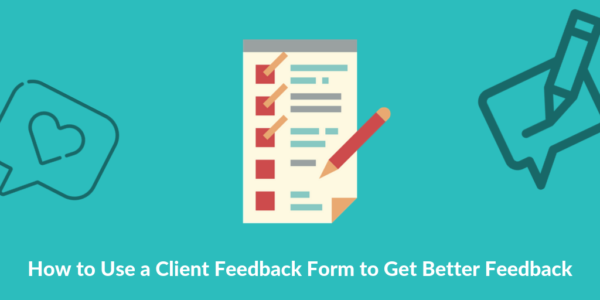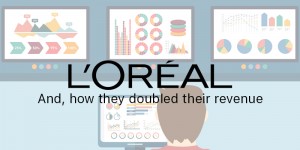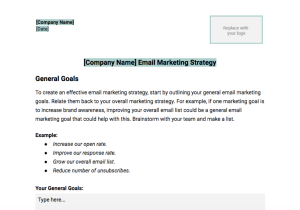— September 20, 2019

As a project manager, it’s your job to make sure that your client is happy and that his or her project is moving in the right direction. So it’s essential to make sure you have a strategy for collecting feedback that will keep your clients happy.
Here’s a look at the ways to make the most of a client feedback form that will boost your results…
Why Should You Ask Your Clients for Feedback about Their Own Projects?
There are three key reasons to ask for client feedback:
1. Improve results (short- and long-term).
Client feedback can really help you boost the quality of your projects on both micro and macro levels. Since effective feedback can help you properly perform each task, your long-term results will also be more impressive.
2. Increase client retention.
As a project manager, you wear a lot of hats. You want to juggle everything and make sure you create the best work possible while you keep your clients happy. A smooth feedback process will show your clients that you care about them and the success of their projects.
If you can nail the feedback process each time, you’ll forge deeper, more fruitful connections with your clients, which will boost your chances of retaining clients.
3. Work more efficiently.
If you effectively utilize client feedback, you’ll find that your work always hits the mark. When the time comes to effectively boosting the profitability of your projects, every minute counts. You can’t afford to work in a random, rudderless way.
You’ll also find that your team appreciates this effectiveness. All team members want to understand what their assignments are and why they’re doing them. Client feedback forms can provide the answers to these questions.
What Should Your Client Feedback Form Look Like?
You should use two key types of feedback forms: an in-project form and a post-project form. Here’s a closer look at what each of those forms might look like…
In-project Feedback Form
Throughout the course of your project, you’ll want to harness the power of feedback loops. This practice will help you make sure that your project is moving in the right direction, and that your client is happy with your work.
A great client feedback form can make this process very effective. Here are the characteristics of a winning in-project feedback form…
Clear
It’s vital to make sure your feedback form solves more problems than it creates. So it should be very clear and easy to complete. You want to make sure your client knows that you respect his or her time.
To make sure your feedback form makes sense, hire or assign a designer to complete the project. Also, make sure that your feedback form bears your branding. This tactic will elevate its importance, which will increase the chance that your client will fill out the form.
Adaptable
No two projects are alike. It’s important to adapt your form to the specific demands of the project. So you should make sure it’s designed to be easily adjusted. Then your project will make sense for both you and your client.
Accessible
Feedback forms should be accessible and functional from a practical perspective. Does your client prefer to use a specific tool in a particular environment? Is it easy to access your feedback form? How will you share it?
If you make the process as simple and seamless as possible, your client will be more likely to spend the time required to give quality answers.
Which questions and fields to include
If you are going to achieve the above, you’ll need to ask the right questions. Here are the key questions and fields that you should include:
- Quality
- Are the collaterals hitting the mark in terms of quality?
- Are there specific changes that need to be made?
- Processes
- Are you satisfied with our progress?
- Are there certain working methods you would like to adjust?
- Are the project tools appropriate and working well?
- Communication
- Are you satisfied with the level of attention that you are receiving?
- Is there anything we could change in terms of communication?
Post-project feedback form
A post-project feedback form is very important. It gives you the chance to find out how you and your team have performed over the course of your project. Here are some qualities your form should have…
Inspiring
Once your project is all wrapped up, good vibes will flow, so you and your client will both feel great. Therefore, your post-project feedback form should inspire your client to reflect the positives of his or her experience. It should be like the perfect ending to a story and leave your client with a positive memory.
Quantifiable
It’s important to make sure your post-project feedback form enables you to collect a blend of both qualitative and quantitative feedback. You should consider including a range of questions that ask for scores. This tactic will make it easier to gauge your performance over time.
A form that includes quantifiable fields can help you really assess the way you performed in a wide range of areas.
Legal disclaimers
You may want to use some of the most glowing feedback in your marketing collaterals. But you should make sure you notify your client if you do, as it shows you respect him or her.
Which questions and fields to include
If your post-project feedback form is going to be effective, you must cover the following questions and fields:
- Communication
- Did your team share accurate and detailed information?
- Were you quick to respond using the right channels?
- Were the communicate clear and simple to understand?
- Quality
- Did the project hit the mark in terms of quality?
- Were the results achieved in a timely manner?
- Performance
- Did the project achieve the desired results?
- Are internal stakeholders satisfied with the project?
- Tools
- Did we use the right tools?
- Were there any issues with the tools that you used (access/functionality/etc.)?
- Any recommendations or general feedback in terms of the tools?
5 Tips for Using a Client Feedback Form
Here are five tips that will help you get the most from your client feedback form.
Use the feedback well.
If you’re going to get the most from your client feedback form, it’s important to understand that you need to develop a strategy for using the feedback. That is to say, you need to work in a deliberate and considered manner so that you address each and every piece of feedback to avoid any requests falling through the cracks.
If your client takes the time to complete the feedback form, he or she is going to want to see that you’ve properly utilized it. So the client will expect you to adjust his or her project based on the feedback he or she gave you about it.
If you use his or her feedback properly, you’ll delight your clients and give them more faith in your team.
Make sure you respect the client’s answers.
All too often, feedback forms are neglected. Some clients may feel as though the project is already going smoothly and that the form is unnecessary. But it’s important to document the feedback.
You should try to make sure your clients understand why the form is so important, and show them what it can do for them. If you have a series of feedback forms on record, you’ll be able to justify the decisions you’ve made throughout their project.
If you don’t have feedback forms, you might find that you and your stakeholders quickly get lost, which could harm your project and your relationship with your client.
Store your feedback forms.
After you’ve completed your feedback forms, it’s important to store them properly. So you should think about ways to order them logically and easily.
Once you’ve properly organized these forms, it will be very easy to refer back to them. At this point, you’ll have complete control over your project, so you can justify the decisions you make.
You’ll want to keep thorough records of these forms because they chronicle your relationship with the client.
Use the right wording
When it comes to collecting feedback, you’ll want to gather constructive criticism, rather than destructive cynicism. If you use the appropriate wording, you can gently guide your client into giving you the constructive feedback you need. So make sure you use positive vocabulary.
To get more detailed answers, always ask open-ended questions. , rather than simple yes or no questions. In other words, make sure you give your client room to share his or her thoughts.
Conclusion
A great client feedback form can really transform your project. So if you want actionable guidance and transparent feedback, you should make sure you create a client feedback form today!
Business & Finance Articles on Business 2 Community
(61)
Report Post




